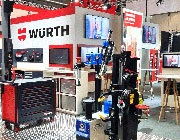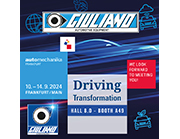
In a retread tyre the worn tread is replaced with new material having
the same characteristics as the original one. Retreading is possible
because the tyre structure has a much longer useful life than the
actual tread. This procedure is governed by strict technical
regulations:
- ECE ONU 108 for motor vehicles
- ECE ONU 109 for commercial vehicles
Approval of retread tyres that come in the field of application of the
above mentioned regulations, is mandatory
This process entails different phases.
Preventive selection
In order to ascertain suitability each tyre is subject to a
tactile/visual inspection by an expert with the aid of instrumental
tests such as the shearography.
Buffing
This operation removes the remaining old tread and prepares the surface
in readiness of the new tread.
Casing inspection and repair
The casing is inspected once again after buffing and any repairs needed
are seen to.
Applying liquid rubber
A layer of liquid rubber is applied that prepares the surface for
receiving the new material.
Applying the new tread
With the hot technique
The casing is mounted on a rotating machine that applies a new band of
raw rubber without any pattern.
With the cold technique
A pre-impressed, vulcanised tread is applied on the casing. The tread
is available either as a band or in the shape of a closed ring. Besides
the flat bands there are also those with side
“wings” for joining their profile to that of the
sides of the casing.
Vulcanisation
With the hot technique
The tyre prepared with a plain profile goes inside a vulcanising press
equipped with a mould with pattern that is impressed on the tyre. The
press has a device to adjust the time, temperature and internal
pressure. When the necessary time has elapsed (which varies according
to the size of the casing and the thickness of the tread) the air is
discharged and the tyre can be taken out of the mould.
With the cold technique
The tyre is mounted on a machine that applies envelopes. Vacuum is
created in order to eliminate any air left between the envelopes and
the tyre prepared with the pre-impressed tread. The tyre then enters an
autoclave for vulcanising. “Baking” time normally
takes: 2.5 - 3.0 hours. Temperature is approximately
110°C.
Checking and finishing
When the retread tyre is taken out of the vulcanising press or
autoclave it undergoes a final internal and external test and is
checked under pressure by specific machines.
Lastly it is given the finishing touches.
Retreading tyres is good for the environment (compared to the
production of a new tyre; with this recycling procedure 70% of energy
is saved and the flow of used tyres to dispose of slows down) and for
your wallet! So why not retread?




